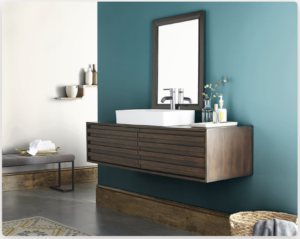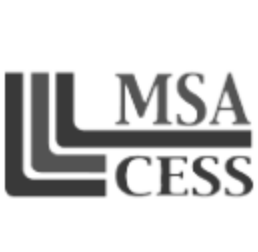Whether you have a ton of space to work with or a little, you can create a cool, functional study spot that is comfortable and productive! This guide has everything you need to set up your study space and prepare for back to school.
How to pick a study spot if you don’t already have one
If you’re unhappy with your current setup, then this section is probably for you. The easiest way to find a study spot that works for you is to identify an area without distraction and one where you will be left in silence. Additionally, look for natural light. If you can find an area that is free of distractions and right next to a window, that is a great place to start setting up a study area. If not, an outlet will do! You can always add sound later if you are the type of learner that needs some ambient noise. Once you have picked an area you deem works for you, ask yourself if it is clean and free of clutter? This will be your next step, to fully clean the area. Discard anything that no longer serves its purpose. If you are still holding on to paperwork, toys, clothing, old digital devices, etc. that you rarely use, consider dumping them. If you are still hesitant about departing with the items right away, put them in a box and label/organize them accordingly so you can still come back to the items. “If you have tons of stuff to clear, do it progressively. Spend 20 minutes a day decluttering, and you’ll have a neat room after a week or so” (Wong).
Let’s review some key elements we’ve established to identifying a study spot:
- Distraction-free
- Quiet
- Natural Light (or power outlet easily within reach for a desk lamp)
Here are some other key factors to consider:
- Wall space for shelving or to hang a cork-board, papers, whiteboard, etc.
- Space for a desk or writing surface plus a chair
- Space to put your essential supplies within reach
If you still are having trouble thinking of ideas of where to set up your study area, we’ve heard of some students who choose the kitchen island or table, the dining room table or a place in the attic, basement, or garage. It may also be interesting and beneficial to read this article from Thoughtco about your learning style, which will help you understand what characteristics your space should mirror to best suit your personality.
Keep things clear!
Once your workspace is identified, clean and set up with essential items like your desk, chair and papers, make sure it is free from distractions – yes, we are talking about digital distractions! Keeping your computer and devices clear of clutter will help you stay organized, less stressed, and concentrated on the goals that matter in school instead of spending 10-30 minutes looking for your homework. An easy suggestion would be to set up a folder on whatever type of digital device you use for school appropriately titled ‘school’. This folder can have subfolders based on the class or topic and then even further organized as; classwork, completed homework, and completed tests as an example.
Once you have organized your computer files and are ready to start studying, make sure to invest in a cloud backup service, flash drive, or other backup product or service connected to your computer. Although most modern devices have an auto-save feature for files, you never want to be in an instance where years of your academic work have been destroyed because you walked away from the computer and your little sister accidentally spilled Hawaiian Punch all over the laptop. Life happens and when it does it feels better to be prepared for it. Invest in a backup product or service for your computer’s files. To read more tips about computer file organization, please click here.
Additionally, California State University Chico offers some great advice on their blog for setting up your study space:
As in so many areas of life, it’s useful to start with what to leave out and then add things from there. Naturally, what puts you in a studious mood will differ from person to person, but here are some things you should probably avoid in your study space:
* Video games.
* Your phone.
* Lots of open tabs (link to study apps for students that can help avoid this).
* Multiple monitors unless it’s really imperative to your work (a separate external monitor is fine if you’re using it as your main screen or as part of a standing desk setup).
* Messy food/drinks/junk food.
* Other people (unless you’re working on a group project, in which case you should be working somewhere else).
In addition to having the right materials, here are a few more principles that will make your study space (and study time) more effective:
1. Make sure all your study materials are functioning. Do this before you start studying. You can get derailed easily if something stupid happens like your pen isn’t working, your pencil runs out of lead, or your computer isn’t charged.
2. Make your study space ergonomic. Don’t slouch, keep your feet on the floor, position your screen at eye level (otherwise you’ll wreck your neck), and type with your wrists in a neutral position. For an illustration of this, have a look at this graphic from Zapier.
3. Keep your study space as clean (or messy) as you like. Some research suggests that messy spaces can be better for creative work, since they encourage unconventional thinking. Other productivity experts swear by a minimalist, decluttered desk. Really, I think it comes down to personal preference. If a cluttered study space works best for you, then rock on. If you can’t stand to have things messy, then don’t. I would, however, suggest you experiment with both ways, as the results might surprise you. Whatever you do, don’t let old pizza or take-out boxes pile up–that’s just gross.
4. Take breaks every 30-60 minutes. Besides being good for your health, regular breaks also boost your productivity and focus. (“4 Steps to Create a Study Space in Your Room”)
We hope that the information cited from California State University is helpful in setting up your study area!
Fill the space with essential supplies you need to complete schoolwork.
Here is a handy list:
- Desk
- Lamp
- Comfortable yet ergonomic chair
- Desktop Computer, Laptop or Tablet
- Binders
- Notebooks or Legal Pads
- Sticky-notes
- Computer Printer Paper
- Printer/Scanner and Ink
- Wall Calendar or Planner
- Pencils
- Pens (My favorite pens are Paper Mate Flair Pens in Black but they also come in a rainbow of colors)
- Paperclips
- Pen and Pencil Cup Holder
- Headphones
- Tactile Thinking Aids (Rubik’s cube, putty/clay)
- Calculator
- Stapler and staples
- Hole-Puncher
- Cork Board or White Board
- 4 cube-storage box/area/library
- Flashdrive or backup cloud service
My room is small and there is no other area in the house to really study, help!
You are not alone if you are a teenager with a small bedroom or one that shares their bedroom with a brother or sister. Many teenagers across the country share this narrative of finding it hard to study in cramped quarters. For this reason, we wanted to dedicate a section of this article to providing tips and resources for maximizing a small space.
• Folding table or wall table – If space is very limited and you cannot fit another chair in your room, opt for a folding table or mounted wall table. That way you can use your bed as a chair and still write/study!
• Draw the eye up – “If you’re stuck in a small, narrow space but are blessed with high ceilings, maximize their benefits. Go the gallery wall route, adorning your walls with a collection of your favorite photos and prints all the way up to the molding. Or try adding floor-to-ceiling bookshelves to sneak in extra storage” (Leavitt).
• Make storage stylish – If the best place to study is in your bedroom and you have to maximize space, there are some great, affordable options available at Walmart or Target that can be delivered such as cube storage. You can also have fun purchasing different storage bins that match your style and personality since bin designs vary in color, texture and prints! A four-cube organizer can serve as a nightstand and storage area for books, beauty supplies, or anything else that needs to stay out of your desk area! You can also opt for a trunk.
• Create a closet study space – Now here is an Instagram trend that works for small bedroom areas! If you have a small bedroom that has a closet, you can turn the closet into your study nook. “With a few pieces of MDF and L-brackets, you can easily create a workspace area” (Hunter).

• Build a loft bed study area – If your bottom bunk has turned into a storage area, why not repurpose it as a study nook? We’ve seen spaces where lights are hung behind the bed and also wrapped up the bed ladder, or students who mount a corkboard, mirror or chalkboard on the back wall… the possibilities are truly endless if you get creative! Click here for more inspiring ideas for setting up a bed/loft study area.
• Insert nature – Add some inspiration to your room by getting a plant or fish! A simple betta or goldfish can do the trick or try adding a succulent or cacti plant as they don’t need much maintenance to take care of.
• Avoid dark colors – Smaller rooms open up with bright or beige colors. Dark colors are better suited for large, well-lit rooms. If you notice your room is a tad dark, your mood and productivity will be boosted with a brighter color. Behr always carries great wall paint colors. A good color combination would be to pair ‘smokey white’ with a blue accent wall like ‘caribe’.
Ergonomics matter
Once your study spot is setup and you are ready to start working or studying, take notice to how you feel and how your posture looks when you are working within your new space. An important tip to avoid neck and upper back pain is to set your laptop or computer monitor at eye level. I’m tall, so I prefer to work off of a stand-up desk. Even though I work off of a stand-up desk, I still need a 3-inch platform so that my computer monitor is raised and is at my eye level. You don’t have to spend a ton of money to raise your laptop or monitor. I’ve stacked hardcover books on-top of each other as a make-shift platform when traveling with my iMac. The most important factor to note is that eye level simply means looking straight ahead. If you slip a book under your laptop and find yourself still looking down at the screen, you will need to add more height. Another at-home DIY tip to support your wrists when typing is to simply roll up a dish-cloth, wash-cloth or sock, (really any type of small fabric that you can fold or rollover) so that you can make a cushion to place under your wrists while typing. Staples carries a variety of wrist and mouse pads, which you can view by clicking here. This full computer glove seems like a useful option for students, teachers or workers who use the computer full-time.
Another health tip for those who use the computer often is to research the effects of blue light on the eyes and decide what your best option is. There has been debate over the past few years with a variety of information available online from the medical community. Personally, I have a prescription that protects my eyes from blue light and feel that it has helped with eye-strain and headaches. We’ve put together some helpful resources about this topic below:
To watch a quick video about posture and ergonomics, please click this link from the Berkeley University of California.
Bibliography
“4 Steps to Create a Study Space in Your Room.” Csuchico.Edu, www.csuchico.edu/stemconnections/_assets/documents/study-room.pdf. Accessed 28 Aug. 2021.
Hunter, Beth. “20 Do It Yourself Study Spaces.” Home Stories A to Z, 30 July 2019, www.homestoriesatoz.com/diy/20-do-it-yourself-study-spaces.html.
Keeley, Joe. “9 Key Tips for Managing and Organizing Your Computer Files.” MUO, www.makeuseof.com/tag/creating-order-chaos-9-great-ideas-managing-computer-files. Accessed 28 Aug. 2021.
Leavitt, Elly. “The Number-One Small-Space Decorating Mistake, According to Nate Berkus.” Pocket, Domino, getpocket.com/explore/item/the-number-one-small-space-decorating-mistake-according-to-nate-berkus?utm_source=pocket-newtab. Accessed 1 Sept. 2021.
“Why It’s Important to Know Your Learning Style.” ThoughtCo, www.thoughtco.com/knowing-your-learning-style-1857098. Accessed 28 Aug. 2021.
Wong, Daniel. “15 Things Students Should Do Before Starting the New School Year.” Daniel Wong, 25 June 2020, www.daniel-wong.com/2015/12/21/new-school-year.
“Work at Home Tips.” UC Ergonomics, www.ergo.berkeley.edu/work-at-home-tips. Accessed 15 Sept. 2021.
















